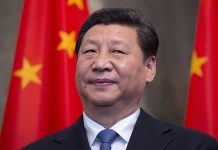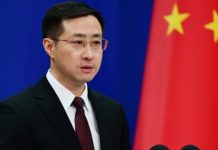
Xinjiang Uygur Auto-nomous Region is a vital gateway to further connect China with the West. In recent years, the region has embraced a new phase of development, aligning with the country’s broader development strategy. Xinjiang’s focus has been on harmonizing economic growth with social stability and enhancing the quality of life for its residents. This approach prioritizes high-quality development, which highlights innovation, efficiency and sustainability, and underscores the importance of long-term initiatives aimed at ensuring lasting peace and security.
The policies and legal frameworks implemented in Xinjiang effectively protect and enhance the rights and welfare of all communities within the region, which is home to all of China’s 56 ethnic groups. Xinjiang is currently experiencing a period of unparalleled safety, economic development and progress in human rights.
Nevertheless, these advancements have faced skepticism and criticism from the United States and some of its allies. But their accusations of human rights abuses in Xinjiang, including “forced labor” allegations, are unsubstantiated. These false narratives are indeed a pretext for interfering in China’s internal affairs, as well as part of the efforts to undermine the country’s economic initiatives that benefit the diverse ethnic groups in Xinjiang. But such tactics will ultimately prove ineffective.
A prerequisite
Since the 18th National Congress of the Communist Party of China (CPC) in November 2012, the Party’s policies for the governance of Xinjiang in the new era has highlighted social stability and lasting security as the overarching goal and underlined the guidelines of governing Xinjiang in accordance with the law, maintaining stability in the region through ethnic unity, nourishing the cultures of Xinjiang, promoting prosperity among the local population, and developing Xinjiang from a long-term perspective.
Xinjiang is transforming itself into a crucial corridor connecting Asia and Europe. Over the past few years, notable progress has been evident at the Urumqi International Land Port, a pivotal project within the core area of cooperation under the Belt and Road Initiative, a China-proposed initiative to boost connectivity along and beyond the ancient Silk Road routes. The rapid development of the Kashgar Economic Development Zone and the Horgos Economic Development Zone has also fueled the region’s growth. These initiatives, among others, focus on improving the region’s infrastructure and connectivity.
In 2022, Xinjiang’s foreign trade imports and exports hit a record high of more than 2.4 trillion yuan ($342.3 billion), marking a year-on-year increase of 57 percent. This growth rate was 49.3 percentage points above the national average, making Xinjiang the leading region in the country for this metric.
The region also emphasizes the creation of “eight major industrial clusters,” achieving notable success in industries such as petroleum, chemicals, silicon-based new materials and modern coal chemicals.
In 2022, Xinjiang emerged as a domestic leader in industrial silicon and polycrystalline silicon production, contributing significantly to both national and global output. It accounted for 42.2 and 41.4 percent of the total national production, and 33.6 and 34.1 percent of the total global production, respectively.
In terms of energy production, Xinjiang has solidified its status as a key national strategic hub, with coal production surpassing 400 million tons in 2022. The region has made substantial contributions to national energy security through cross-provincial coal transportation and power transmission. Moreover, Xinjiang has also seen remarkable growth in renewable energy production, with an installed capacity exceeding 44 million kilowatts, accounting for nearly 40 percent of total regional power generation capacity.
Agriculturally, Xinjiang is a vital source of high-quality products, particularly excelling in grain, oil crops and cotton production, thus playing a pivotal role in ensuring national food security.
The region has actively worked toward elevating the sustainability of its cotton industry.
Conventional cotton production can have significant environmental impacts and sustainability challenges. For example, this type of farming often involves the heavy use of pesticides, which can lead to soil degradation, water pollution and biodiversity loss. Moreover, the cotton industry is notorious for its significant water consumption, as the use of water-intensive irrigation methods exacerbates water scarcity in certain areas.
In the pursuit of more sustainable practices, Xinjiang has initiated a program focused on cultivating high-quality cotton in an efficient manner. With a consistent total cotton yield surpassing 5 million tons annually, Xinjiang maintains its leading position in China’s cotton industry.
Xinjiang plays a vital part in safeguarding national security as a major battleground against separatism and terrorism. Persistent, law-based counterterrorism endeavors have ensured social stability in the region.
For years, over 70 percent of the region’s annual fiscal expenditures have been allocated to improving residents’ livelihoods, consolidating poverty alleviation results and advancing rural revitalization. Rural revitalization is a strategy to boost economic development and living standards in rural areas through targeted policies and investments, narrow the urban-rural gap, and promote the fair distribution of development benefits.
Additionally, Xinjiang has launched various initiatives to develop local cultures and foster ethnic unity.
Navigating progress
“Putting the people first” is a basic governance philosophy of the CPC. President Xi Jinping has emphasized on multiple occasions that enhancing the living standards of the population through economic growth is the primary objective of the Party and the state.
China currently grapples with uneven and insufficient development, particularly evident in the disparities between the country’s eastern and western regions. The country is addressing the challenges by implementing policies that cater to specific local needs, enhancing legal protection for human rights and ensuring equal opportunities for all citizens. These efforts have resulted in improvements in areas such as education, employment, healthcare and housing across the country.
Data from the National Bureau of Statistics reveal significant economic progress in Xinjiang. In 2023, the per-capita disposable income of the region reached 28,947 yuan ($4,023), marking a ninefold increase since 2000.
The regional GDP for the same year exceeded 1.91 trillion yuan ($270 billion), up 6.8 percent from the previous year, with retail sales climbing to 384.9 billion yuan ($53.5 billion), an 18-percent year-on-year increase. Markedly, auto sales saw a 44-percent surge in 2023.
Xinjiang is leveraging its natural resources to develop a modern industrial system, focusing on oil and gas production, coal and coal-related industries, greener mining, grain and oil crops, textiles and garments, vegetable and fruit growing, livestock products and strategic emerging sectors such as new materials. These efforts aim to strengthen Xinjiang’s contribution to national energy and food security.
Infrastructure development is another priority, with efforts focused on enhancing regional connectivity, expanding transportation networks, and international collaborations like the China-Kyrgyzstan-Uzbekistan, China-Kazakhstan and China-Pakistan international railway projects.
The Xinjiang authorities prioritize raising living standards by emphasizing job creation, education, healthcare, senior care and housing security. These measures aim to enhance residents’ senses of fulfillment and safety.
The government has adopted a “job first” strategy. In 2023 alone, this approach resulted in the creation of over 460,000 new urban jobs and the provision of more than 2.75 million job opportunities for local rural residents.
On a final note, environmental protection and ecological management, especially in critical areas like the Tarim Basin in south Xinjiang, along with efforts toward carbon peaking and energy conservation, demonstrate the overall commitment to creating a sustainable and beautiful Xinjiang. –The Daily Mail-Beijing Review news exchange item




